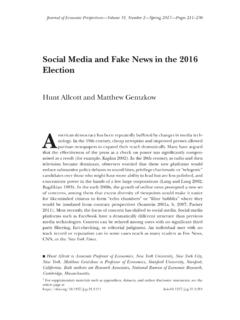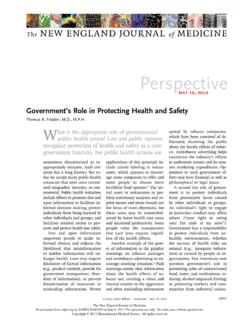Transcription of Misinformation in Social Media: Definition, Manipulation ...
1 Misinformation in Social media : Definition, Manipulation ,and DetectionLiang Wu , Fred Morstatter , Kathleen M. Carley , and Huan Liu Arizona State University, Tempe, AZ, USA USC Information Sciences Institute, Marina Del Rey, CA, USA Carnegie Mellon University, Pittsburgh, PA, USA{wuliang, widespread dissemination of Misinformation in socialmedia has recently received a lot of attention in the problem of Misinformation in Social media hasbeen intensively studied, there are seemingly different def-initions for the same problem, and inconsistent results indifferent studies.}
2 In this survey, we aim to consolidate theobservations, and investigate how an optimal method canbe selected given specific conditions and contexts. To thisend, we first introduce a definition for Misinformation in so-cial media and we examine the difference between misinfor - mation detection and classic supervised learning. Second,we describe the diffusion of Misinformation and introducehow spreaders propagate Misinformation in Social , we explain characteristics of individual methods ofmisinformation detection, and provide commentary on theiradvantages and pitfalls.
3 By reflecting applicability of dif-ferent methods, we hope to enable the intensive research inthis area to be conveniently reused in real-world applicationsand open up potential directions for future INTRODUCTIONThe openness and timeliness of Social media have largelyfacilitated the creation and dissemination of Misinformation ,such as rumor, spam, and fake news. As witnessed in recentincidents of Misinformation , how to detect misinformationin Social media has become an important problem.
4 It isreported that over two thirds adults in US read news fromsocial media , with 20% doing so frequently1. Though thespread of Misinformation has been studied in journalism,the openness of Social networking platforms, combined withthe potential for automation, facilitates Misinformation torapidly propagate to a large group of people, which bringsabout unprecedented definition, Misinformation is false or inaccurate infor- mation that is deliberately created and is intentionally orunintentionally propagated.
5 However, as illustrated in Fig-ure 1, there are several similar terms that may easily getThe review article has been partially presented as a tutorialat SBP 16 and ICDM 171 1: Key terms related to with Misinformation . For example, disinformationalso refers to inaccurate information which is usually dis-tinguished from Misinformation by the intention of decep-tion, fake news refers to false information in the form ofnews (which is not necessarily disinformation since it maybe unintentionally shared by innocent users), rumor refersto unverified information that can be either true or false,and spam refers to irrelevant information that is sent to alarge number of users.
6 A clear definition is helpful for estab-lishing a scope or boundary of the problem, which is crucialfor designing a machine learning challenge is that results on similar problems can of-ten be inconsistent. It is usually caused by the heterogeneityof various Misinformation applications, where different fea-tures, experimental settings, and evaluation measures maybe adopted in different papers. The inconsistency makesit difficult to relate one method to another, which hindersthe research results to be applied in real-world this end, this survey aims to review existing approachesand literature by categorizing them based on the datasetsand experimental settings.
7 Through examining these meth-ods from the perspective of machine learning, our goal isto consolidate seemingly different results and observations,and allow for related practitioners and researchers to reuseexisting methods and learn from the this work, we aim to (1) introduce a definition for misin-formation in Social media that helps establish a clear scopefor related research; (2) discuss how Misinformation spread-ers actively avoid being detected and propagate misinfor - mation ; and (3) review existing approaches and consolidatedifferent results, observations and methods from the per-spective of machine learning.
8 As we discussed earlier, a def-inition for Misinformation in Social media can help a detec-tion method to focus on the specific scope of the studying the diffusion process of Misinformation ,and how Misinformation spreaders manage to avoid beingdetected, we will introduce methods that are robust to suchadversarial attacks. By reviewing existing approaches basedon the datasets, features, and experimental settings, it isfound that the performance of a method relies on the pro-vided information of a problem, such as the availability ofcontent and network data, and the requirements of a solu-tion, and thus no single method is superior over the rest.
9 Wehope these findings will make existing research and resultshandy for real-world rest of the paper is organized as follows. Section 2presents a definition for Misinformation and discusses severalrelated concepts. Section 3 examines Misinformation diffu-sion and several types of adversarial attacks of misinforma-tion spreaders, and introduces countermeasures that makea detection system robust to such attacks. Section 4 intro-duces Misinformation detection methods, which focuses onoptimizing both accuracy and earliness.
10 Section 5 discussesfeature engineering methods, available datasets, ground truthand evaluation methods. Section 6 concludes the survey, andprovide several future directions in this Misinformation DEFINITIONT here are several related terms similar to than the concepts are relatively easier to distinguish,such as spam (a large number of recipients) rumor (verifiedor unverified) and fake news (in the format of news), themost similar or confusing term is disinformation. misinfor - mation and disinformation both refer to fake or inaccurateinformation, and a key distinction between them lies in theintention - whether the information is deliberately created todeceive, and disinformation usually refers to the intentionalcases while Misinformation the unintentional.

